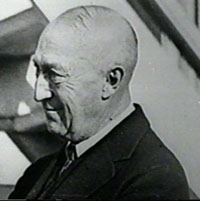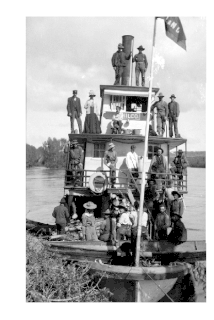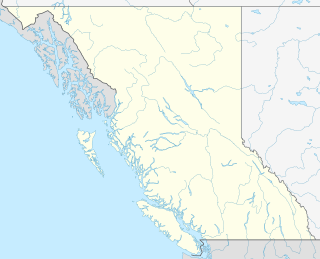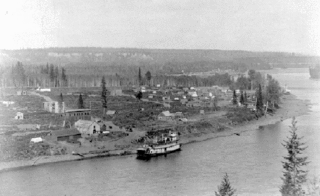
Prince George is the largest city in northern British Columbia, Canada, with a population of 74,004 in the metropolitan area. It is often called the province's "northern capital" or sometimes the "spruce capital" because it is the hub city for Northern BC. It is situated at the confluence of the Fraser and Nechako rivers, and at the crossroads of Highway 16 and Highway 97.

The Grand Trunk Pacific Railway was a historic Canadian transcontinental railway running from Winnipeg to Prince Rupert, British Columbia, a Pacific coast port. East of Winnipeg the line continued as the National Transcontinental Railway (NTR), running across northern Ontario and Quebec, crossing the St. Lawrence River at Quebec City and ending at Moncton, New Brunswick. The Grand Trunk Railway (GTR) managed and operated the entire line.

Hazelton is a village located at the junction of the Bulkley and Skeena Rivers in northern British Columbia, Canada. It was founded in 1866 and in 2011 had a population of 305. The nearby larger community of New Hazelton is the northernmost point of the Yellowhead Highway, a major interprovincial highway which runs from Prince Rupert, British Columbia, to Portage la Prairie, Manitoba.

Charles Vance Millar was a Canadian lawyer and financier. He was the president and part-owner of the Toronto brewery of O'Keefe Brewery. He also owned racehorses, including the 1915 King's Plate–winning horse Tartarean. However, he is now best known for his unusual will which touched off the Great Stork Derby.

Barnard's Express, later known as the British Columbia Express Company or BX, was a pioneer transportation company that served the Cariboo and Fraser-Fort George regions in British Columbia, Canada from 1861 until 1921.
The Lheidli T'enneh Band also known as the Lheidli T'enneh First Nation and historically known as the Fort George Indian Band is the First Nations band government for the Lheidli T'enneh, a subgroup of the Dakelh people whose traditional territory includes the City of Prince George, British Columbia. The name means "The People from the confluence of the two rivers" in the Carrier language referring to how the Nechako River enters the Fraser River at Prince George. The rivers spoken of are the Nee Incha Koh which means “river with strong undercurrents” and the Ltha Koh, the Big Mouth River.

Twelve paddlewheel steamboats plied the upper Fraser River in British Columbia from 1863 until 1921. They were used for a variety of purposes: working on railroad construction, delivering mail, promoting real estate in infant townsites and bringing settlers in to a new frontier. They served the towns of Quesnel, Barkerville and Fort George. Some only worked the Fraser from Soda Creek to Quesnel, while others went all the way to Tête Jaune Cache or took the Nechako River and served Fort Fraser and beyond.
John Houston was a newspaper publisher and politician in British Columbia.

The Conveyor was one of five sternwheelers built for the use on the Skeena River by Foley, Welch and Stewart for construction work on the Grand Trunk Pacific Railway. The other four were the Operator, the Skeena, the Distributor and the Omineca. Three of these, the Conveyor, the Operator and the Distributor were built at Victoria, British Columbia in 1908 by Alexander Watson Jr.

The BX sternwheeler was the first of two river steamers built for service on the upper Fraser River by the BC Express Company during the busy era of Grand Trunk Pacific Railway construction. The BX was built at Soda Creek in early 1910 by Alexander Watson Jr, of Victoria, who was one of British Columbia's foremost shipbuilders and the son of the man who had built the Charlotte. The BC Express Company also hired Captain Owen Forrester Browne to be the master of the BX as he was the most experienced upper Fraser River pilot.

The Operator sternwheeler was one of five sternwheelers built for the use on the Skeena River by Foley, Welch and Stewart for construction work on the Grand Trunk Pacific Railway. The other four were the Conveyor, the Skeena, the Distributor and the Omineca. Three of these, the Conveyor, the Operator and the Distributor were built at Victoria, British Columbia, in 1908 by Alexander Watson Jr.

The BC Express was a stern wheel paddle steamer (sternwheeler) that operated on the Fraser River in British Columbia, Canada, from 1912 to 1919. The BC Express was built for the BC Express Company by Alexander Watson, Jr to work on the upper Fraser River between Tête Jaune Cache and Fort George during the busy years of Grand Trunk Pacific Railway construction. The BC Express Company hired Captain Joseph Bucey, an experienced Skeena River pilot, to be her master.

New Hazelton is a district municipality on Highway 16 in northwest British Columbia, Canada. It is situated 133 km (83 mi) northeast of Terrace and 68 km (42 mi) northwest of Smithers and in 2016 had a population of 580 people, a decrease of 12.9% comparing to 2011. New Hazelton is one of the "Three Hazeltons", the other two being the original "Old" Hazelton located 6 km (4 mi) to the northwest very near to the confluence of the Skeena and Bulkley Rivers and South Hazelton, 5 km (3 mi) to the west.

The Last Spike of the Grand Trunk Pacific Railway was driven one mile east of Fort Fraser, British Columbia, Canada on April 7, 1914.

The Giscome Portage was a portage between the Fraser River and Summit Lake, which connected with the river route to the Peace Country via Finlay Forks. BC Parks administers the Giscome Portage Trail. The Huble Homestead Historic Site, at the south end, is on the Fraser River, 40 kilometres (25 mi) north of Prince George and 6 kilometres (3.7 mi) off Highway 97.

Stephen Tingley was a stagecoach driver and one of the original owners of the pioneer transportation company BC Express that served the Cariboo region in British Columbia, Canada for 60 years, from 1860, when it was first founded as Barnard's Express, until 1920, when it ceased its sternwheeler service.

John Henry Bonser was a steamship captain from Oregon, United States and British Columbia, Canada. He piloted dozens of sternwheelers over his 40-year-long career and pioneered many rivers in the Pacific Northwest.

South Fort George is a suburb of Prince George, British Columbia, Canada.

Nicolas Coccola was a French Oblate missionary in British Columbia, Canada from 1880 until his death in 1943.

The Grand Trunk Pacific dock was a shipping pier in Seattle, Washington. The original pier was built in 1910 and was destroyed in a fire in 1914. The pier was then rebuilt and continued in existence until 1964, when it was dismantled. The area where the pier stood is now part of the Seattle terminal of the Washington State Ferry system.

















